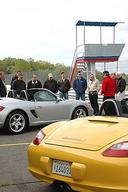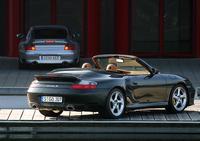TC's 2005 Porsche Line-up Test Rides
By Thom Cannell
The Auto Channel
Short of a million-dollar lottery winner, an invitation to drive Porsches on a race track runs close second. With a million dollars you can own a Porsche!
Thus I, and various other media racer-wannabes gathered for a day of very high speed entertainment at Waterford Hills Road Racing track. After a short business meeting charting Porsche’s latest developments we
 |
Porsche brought five different open cars: Boxter and Boxter S, the 911 Carrera Cabriolet and Carrera S Cabriolet, and a 600 horsepower (that’s SIX-HUNDRED-HORSEPOWER) 205 mph (yes, TWO-HUNDRED AND FIVE BLOODY MILES PER HOUR!) Porsche Carrera GT priced at $440,000. Excuse me a moment for deep breaths… Fortunately I got up to speed in a Boxter S before driving the GT.
Porsche Boxter S $53,100
The 2005 Boxter , at eight years old, is in its second generation. This
mid-engined ragtop now has brakes from a 911 (bigger and stronger) and
improved stability control (Porsche Stability Management.)
 |
There’s room for taller drivers and a 240 horsepower 2.7-liter engine that sprints to 60 mph in under 6 seconds. S models have a larger, 3.2-liter engine with 280 horsepower connected to a six-speed manual. Either incorporates six airbags: driver and passenger, thorax, and head.
Motoring out of the pits, into turn 1 (follow along on the track map www.waterfordhills.com) I could feel an improvement in the shifter – it’s 26% shorter throw makes it quick and slick. Accelerating into turn four—uphill, blind—brakes felt smooth, strong and easy to apply in a very graduated amount. Great brakes are a Porsche hallmark.
Quickly down the hill and into sweeping turn five, there was no chassis flex, and plenty of torque on exit onto the long back straight.
911 Carrera Cabriolet $79,100
The next car, an “ordinary” Porsche Carrera Cabriolet, was
equipped with Tiptronic, Porsche’s steering-wheel mounted manual
 |
Part of the art of driving well, and fast, involves knowing when to brake, and how much brake to apply. Often the amount of brakes was (to me, not the professional beside me) barely perceptible. A slight change of balance to the front makes tires bite as direction changes. It felt as though I only turned on the brake lights! There are few vehicles with this level of excellence in brakes.
911 Carrera S Cabriolet $88,900
Unlike the Carrera, the S Cabriolet was equipped with a 6-speed manual, but
 |
The Carrera S has larger brakes, 330 mm (12.99”) front and rear, with distinctive red four-piston monoblock calipers. It was equipped with Porsche Active Suspension Management. This lowers the car by 10 mm in
 |
Like a lineman taking a set, or a martial artist exhaling before a blow, the Carrera S felt poised to attack each corner. S models have more horsepower, 355 from a 3.8-liter engine. And all Carreras now have variable-ratio steering. Beyond 15° plus/minus of center, steering changes from 2.98 turns lock-to-lock to 2.62. Steering columns tilt and telescope. You can tell the Carrera from S models by tailpipes. S models have twin round tailpipes and red brake calipers, Carrera’s have two oval pipes and natural-colored calipers.
Carrera GT $440,000
Saved the best for last, I did. I’ve driven million-dollar
prototypes, and even a fuel cell test car valued at $11,000,000.
That’s not the same as driving a car that can actually reach 330 kmh
(205 mph.) This was a real car, an “everyday” driver.
 |
The amazing thing, this supercar is easy to drive. I mean, you could get groceries! Well, if you put the grocery bag in the passenger seat; there’s barely room for a six-pack under the hood once the top panels are stored. You’re seated low, profilin’ in the extreme, surrounded by acres of bonded carbon fiber chassis. Behind you is a racing engine that is a stressed chassis member like a Formula 1 car. Pedals are bottom-hinged and feel unusual; you can push your heel against them with no change in pedal angle, which makes it easy to be gentle with the controls.
Oddly, the Carrera GT is easier to drive than a Viper or Corvettet Z 06. It feels more refined, more balanced, less edgy. I’d love to have one for the typical week-long test drive. Instead I’m back to mundane vehicles, an Audi A4 Avant, Infiniti Q45, Mazda 3s, and no race track to test them.
copyright 2005 Thom Cannel



